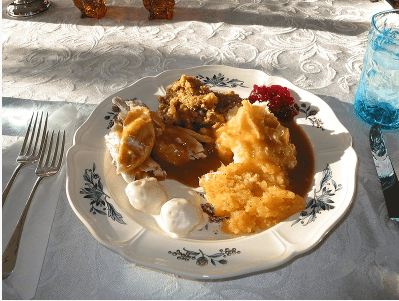
If you’ve ever been at Esalen during Thanksgiving week, you’ve probably noticed that our Thanksgiving feast is the best, ever. That’s because we love Thanksgiving. We put tons of love into sharing our favorite dishes, from our own traditions, with the Esalen community. We also use good organic, heritage turkeys that have way more flavor than your standard Butterball turkey. Since they’ve had a more active life, they’re a bit smaller and have more muscle development, which means more connective tissue. We take extra care to cook them in a way that won’t dry them out.
Over the years, we’ve worked out how to make this feast for 300+ people and still retain the magic, cozy comfort of a home cooked meal. When cooking a Thanksgiving feast for a crowd at home it’s a great idea to use some of the tricks that the pros use, since this meal requires bringing a lot of things together at the same time. It can get pretty hectic if you don’t have a strategy.
We’re going to share with you a great way to deal with the turkey equation (essential when cooking 25 turkeys, as we do) that will allow you to master several important elements of the big meal, and turn typical challenges into opportunities for greatness.
In order to address these three realities, professional cooks who are cooking for a crowd will generally dispense with the homey fantasy of pulling a whole roasted bird out of the oven while the guests gather ‘round the table (and whipping up a little pan gravy in the roasting dish) and opt instead for a more organized and comprehensive approach to dealing with the bird(s). This means that we take the turkeys apart prior to cooking them.
We want the best of everything, we love full utilization, plus we want time to spare, since no one can be in two places at once. After all, if we have a choice between stressing out in the kitchen Thursday afternoon or hanging out with our loved ones drinking wine, we’ll take the second option.
Get your turkey far enough in advance that you can thaw it in the fridge for a couple of days, and still have at least one day to spare. On Tuesday or Wednesday, take apart the turkey. First, remove the legs and thighs from the body. There are good videos online that show how to do this. Then, you’re going to wing tips, and then remove the breast, both sides together, with the bone in. There are good videos on YouTube that show how to do this, as well. Brine the breasts, legs, thighs, and wings with salt sugar and spices as follows, and save the parts for making stock in Step 3.
Ingredients
Method
Ingredients
Method
Ingredients
Method
Now you’ve got a perfectly roasted, flavorfully seasoned, crispy skinned turkey; a rich, smooth, intensely flavored gravy, with a perfect balance of roasty umami, warm spices, cooling herbal notes, and acidity (from the wine) to bring all of the flavors into focus; and delicious, moist, flavorful stuffing.
And remember, all of this is done ahead of time (in the morning, or the day before) leaving you time on Thursday afternoon to hang out with loved ones.

“Remembering to be as self compassionate as I can and praying to the divine that we're all a part of.”
–Aaron
“Prayer, reading, meditation, walking.”
–Karen
“Erratically — which is an ongoing stream of practice to find peace.”
–Charles
“Try on a daily basis to be kind to myself and to realize that making mistakes is a part of the human condition. Learning from our mistakes is a journey. But it starts with compassion and caring. First for oneself.”
–Steve
“Physically: aerobic exercise, volleyball, ice hockey, cycling, sailing. Emotionally: unfortunately I have to work to ‘not care’ about people or situations which may end painfully. Along the lines of ‘attachment is the source of suffering’, so best to avoid it or limit its scope. Sad though because it could also be the source of great joy. Is it worth the risk?“
–Rainer


“It's time for my heart to be nurtured on one level yet contained on another. To go easy on me and to allow my feelings to be validated, not judged harshly. On the other hand, to let the heart rule with equanimity and not lead the mind and body around like a master.”
–Suzanne
“I spend time thinking of everything I am grateful for, and I try to develop my ability to express compassion for myself and others without reservation. I take time to do the things I need to do to keep myself healthy and happy. This includes taking experiential workshops, fostering relationships, and participating within groups which have a similar interest to become a more compassionate and fulfilled being.“
–Peter


“Self-forgiveness for my own judgments. And oh yeah, coming to Esalen.”
–David B.
“Hmm, this is a tough one! I guess I take care of my heart through fostering relationships with people I feel connected to. Spending quality time with them (whether we're on the phone, through messages/letters, on Zoom, or in-person). Being there for them, listening to them, sharing what's going on with me, my struggles and my successes... like we do in the Esalen weekly Friends of Esalen Zoom sessions!”
–Lori

“I remind myself in many ways of the fact that " Love is all there is!" LOVE is the prize and this one precious life is the stage we get to learn our lessons. I get out into nature, hike, camp, river kayak, fly fish, garden, I create, I dance (not enough!), and I remain grateful for each day, each breath, each moment. Being in the moment, awake, and remembering the gift of life and my feeling of gratitude for all of creation.”
–Steven
“My physical heart by limiting stress and eating a heart-healthy diet. My emotional heart by staying in love with the world and by knowing that all disappointment and loss will pass.“
–David Z.
Today, September 29, is World Heart Day. Strike up a conversation with your own heart and as you feel comfortable, encourage others to do the same. As part of our own transformations and self-care, we sometimes ask for others to illuminate and enliven our hearts or speak our love language.
What if we could do this for ourselves too, even if just for today… or to start a heart practice, forever?

If you’ve ever been at Esalen during Thanksgiving week, you’ve probably noticed that our Thanksgiving feast is the best, ever. That’s because we love Thanksgiving. We put tons of love into sharing our favorite dishes, from our own traditions, with the Esalen community. We also use good organic, heritage turkeys that have way more flavor than your standard Butterball turkey. Since they’ve had a more active life, they’re a bit smaller and have more muscle development, which means more connective tissue. We take extra care to cook them in a way that won’t dry them out.
Over the years, we’ve worked out how to make this feast for 300+ people and still retain the magic, cozy comfort of a home cooked meal. When cooking a Thanksgiving feast for a crowd at home it’s a great idea to use some of the tricks that the pros use, since this meal requires bringing a lot of things together at the same time. It can get pretty hectic if you don’t have a strategy.
We’re going to share with you a great way to deal with the turkey equation (essential when cooking 25 turkeys, as we do) that will allow you to master several important elements of the big meal, and turn typical challenges into opportunities for greatness.
In order to address these three realities, professional cooks who are cooking for a crowd will generally dispense with the homey fantasy of pulling a whole roasted bird out of the oven while the guests gather ‘round the table (and whipping up a little pan gravy in the roasting dish) and opt instead for a more organized and comprehensive approach to dealing with the bird(s). This means that we take the turkeys apart prior to cooking them.
We want the best of everything, we love full utilization, plus we want time to spare, since no one can be in two places at once. After all, if we have a choice between stressing out in the kitchen Thursday afternoon or hanging out with our loved ones drinking wine, we’ll take the second option.
Get your turkey far enough in advance that you can thaw it in the fridge for a couple of days, and still have at least one day to spare. On Tuesday or Wednesday, take apart the turkey. First, remove the legs and thighs from the body. There are good videos online that show how to do this. Then, you’re going to wing tips, and then remove the breast, both sides together, with the bone in. There are good videos on YouTube that show how to do this, as well. Brine the breasts, legs, thighs, and wings with salt sugar and spices as follows, and save the parts for making stock in Step 3.
Ingredients
Method
Ingredients
Method
Ingredients
Method
Now you’ve got a perfectly roasted, flavorfully seasoned, crispy skinned turkey; a rich, smooth, intensely flavored gravy, with a perfect balance of roasty umami, warm spices, cooling herbal notes, and acidity (from the wine) to bring all of the flavors into focus; and delicious, moist, flavorful stuffing.
And remember, all of this is done ahead of time (in the morning, or the day before) leaving you time on Thursday afternoon to hang out with loved ones.

“Remembering to be as self compassionate as I can and praying to the divine that we're all a part of.”
–Aaron
“Prayer, reading, meditation, walking.”
–Karen
“Erratically — which is an ongoing stream of practice to find peace.”
–Charles
“Try on a daily basis to be kind to myself and to realize that making mistakes is a part of the human condition. Learning from our mistakes is a journey. But it starts with compassion and caring. First for oneself.”
–Steve
“Physically: aerobic exercise, volleyball, ice hockey, cycling, sailing. Emotionally: unfortunately I have to work to ‘not care’ about people or situations which may end painfully. Along the lines of ‘attachment is the source of suffering’, so best to avoid it or limit its scope. Sad though because it could also be the source of great joy. Is it worth the risk?“
–Rainer


“It's time for my heart to be nurtured on one level yet contained on another. To go easy on me and to allow my feelings to be validated, not judged harshly. On the other hand, to let the heart rule with equanimity and not lead the mind and body around like a master.”
–Suzanne
“I spend time thinking of everything I am grateful for, and I try to develop my ability to express compassion for myself and others without reservation. I take time to do the things I need to do to keep myself healthy and happy. This includes taking experiential workshops, fostering relationships, and participating within groups which have a similar interest to become a more compassionate and fulfilled being.“
–Peter


“Self-forgiveness for my own judgments. And oh yeah, coming to Esalen.”
–David B.
“Hmm, this is a tough one! I guess I take care of my heart through fostering relationships with people I feel connected to. Spending quality time with them (whether we're on the phone, through messages/letters, on Zoom, or in-person). Being there for them, listening to them, sharing what's going on with me, my struggles and my successes... like we do in the Esalen weekly Friends of Esalen Zoom sessions!”
–Lori

“I remind myself in many ways of the fact that " Love is all there is!" LOVE is the prize and this one precious life is the stage we get to learn our lessons. I get out into nature, hike, camp, river kayak, fly fish, garden, I create, I dance (not enough!), and I remain grateful for each day, each breath, each moment. Being in the moment, awake, and remembering the gift of life and my feeling of gratitude for all of creation.”
–Steven
“My physical heart by limiting stress and eating a heart-healthy diet. My emotional heart by staying in love with the world and by knowing that all disappointment and loss will pass.“
–David Z.
Today, September 29, is World Heart Day. Strike up a conversation with your own heart and as you feel comfortable, encourage others to do the same. As part of our own transformations and self-care, we sometimes ask for others to illuminate and enliven our hearts or speak our love language.
What if we could do this for ourselves too, even if just for today… or to start a heart practice, forever?

If you’ve ever been at Esalen during Thanksgiving week, you’ve probably noticed that our Thanksgiving feast is the best, ever. That’s because we love Thanksgiving. We put tons of love into sharing our favorite dishes, from our own traditions, with the Esalen community. We also use good organic, heritage turkeys that have way more flavor than your standard Butterball turkey. Since they’ve had a more active life, they’re a bit smaller and have more muscle development, which means more connective tissue. We take extra care to cook them in a way that won’t dry them out.
Over the years, we’ve worked out how to make this feast for 300+ people and still retain the magic, cozy comfort of a home cooked meal. When cooking a Thanksgiving feast for a crowd at home it’s a great idea to use some of the tricks that the pros use, since this meal requires bringing a lot of things together at the same time. It can get pretty hectic if you don’t have a strategy.
We’re going to share with you a great way to deal with the turkey equation (essential when cooking 25 turkeys, as we do) that will allow you to master several important elements of the big meal, and turn typical challenges into opportunities for greatness.
In order to address these three realities, professional cooks who are cooking for a crowd will generally dispense with the homey fantasy of pulling a whole roasted bird out of the oven while the guests gather ‘round the table (and whipping up a little pan gravy in the roasting dish) and opt instead for a more organized and comprehensive approach to dealing with the bird(s). This means that we take the turkeys apart prior to cooking them.
We want the best of everything, we love full utilization, plus we want time to spare, since no one can be in two places at once. After all, if we have a choice between stressing out in the kitchen Thursday afternoon or hanging out with our loved ones drinking wine, we’ll take the second option.
Get your turkey far enough in advance that you can thaw it in the fridge for a couple of days, and still have at least one day to spare. On Tuesday or Wednesday, take apart the turkey. First, remove the legs and thighs from the body. There are good videos online that show how to do this. Then, you’re going to wing tips, and then remove the breast, both sides together, with the bone in. There are good videos on YouTube that show how to do this, as well. Brine the breasts, legs, thighs, and wings with salt sugar and spices as follows, and save the parts for making stock in Step 3.
Ingredients
Method
Ingredients
Method
Ingredients
Method
Now you’ve got a perfectly roasted, flavorfully seasoned, crispy skinned turkey; a rich, smooth, intensely flavored gravy, with a perfect balance of roasty umami, warm spices, cooling herbal notes, and acidity (from the wine) to bring all of the flavors into focus; and delicious, moist, flavorful stuffing.
And remember, all of this is done ahead of time (in the morning, or the day before) leaving you time on Thursday afternoon to hang out with loved ones.

“Remembering to be as self compassionate as I can and praying to the divine that we're all a part of.”
–Aaron
“Prayer, reading, meditation, walking.”
–Karen
“Erratically — which is an ongoing stream of practice to find peace.”
–Charles
“Try on a daily basis to be kind to myself and to realize that making mistakes is a part of the human condition. Learning from our mistakes is a journey. But it starts with compassion and caring. First for oneself.”
–Steve
“Physically: aerobic exercise, volleyball, ice hockey, cycling, sailing. Emotionally: unfortunately I have to work to ‘not care’ about people or situations which may end painfully. Along the lines of ‘attachment is the source of suffering’, so best to avoid it or limit its scope. Sad though because it could also be the source of great joy. Is it worth the risk?“
–Rainer


“It's time for my heart to be nurtured on one level yet contained on another. To go easy on me and to allow my feelings to be validated, not judged harshly. On the other hand, to let the heart rule with equanimity and not lead the mind and body around like a master.”
–Suzanne
“I spend time thinking of everything I am grateful for, and I try to develop my ability to express compassion for myself and others without reservation. I take time to do the things I need to do to keep myself healthy and happy. This includes taking experiential workshops, fostering relationships, and participating within groups which have a similar interest to become a more compassionate and fulfilled being.“
–Peter


“Self-forgiveness for my own judgments. And oh yeah, coming to Esalen.”
–David B.
“Hmm, this is a tough one! I guess I take care of my heart through fostering relationships with people I feel connected to. Spending quality time with them (whether we're on the phone, through messages/letters, on Zoom, or in-person). Being there for them, listening to them, sharing what's going on with me, my struggles and my successes... like we do in the Esalen weekly Friends of Esalen Zoom sessions!”
–Lori

“I remind myself in many ways of the fact that " Love is all there is!" LOVE is the prize and this one precious life is the stage we get to learn our lessons. I get out into nature, hike, camp, river kayak, fly fish, garden, I create, I dance (not enough!), and I remain grateful for each day, each breath, each moment. Being in the moment, awake, and remembering the gift of life and my feeling of gratitude for all of creation.”
–Steven
“My physical heart by limiting stress and eating a heart-healthy diet. My emotional heart by staying in love with the world and by knowing that all disappointment and loss will pass.“
–David Z.
Today, September 29, is World Heart Day. Strike up a conversation with your own heart and as you feel comfortable, encourage others to do the same. As part of our own transformations and self-care, we sometimes ask for others to illuminate and enliven our hearts or speak our love language.
What if we could do this for ourselves too, even if just for today… or to start a heart practice, forever?